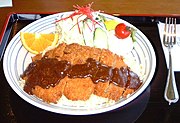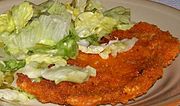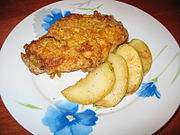Cutlet
This articleneeds additional citations forverification.(February 2012) |
Cutlet(derived fromFrenchcôtelette,côte,"rib"[1][2]) refers to:
- a thin slice ofmeatfrom the leg or ribs ofmutton,veal,[2]pork,or chicken
- a dish made of such slice, oftenbreaded(also known in various languages as acotoletta,Kotelett,kotletorkotleta)
- acroquetteor cutlet-shapedpattymade ofground meat
- a kind of fish cut where the fish is sliced perpendicular to the spine, rather than parallel (as withfillets); often synonymous withsteak
- aprawn or shrimpwith its head and outer shell removed, leaving only the flesh and tail
- a mash of vegetables (usuallypotatoes) fried withbread
American and Canadian cuisines[edit]
From the late 1700s until about 1900, virtually all recipes for "cutlets" in English-language cookbooks referenced veal cutlets. Then pork cutlets began to appear. More recently,[when?]in American and Canadian cuisine, cutlets have also been made using chicken, although this was also imported from Europe. The cutlet is usually coated with flour, egg and bread crumbs, then fried in a pan with some oil.
Austrian cuisine[edit]
Australian cuisine[edit]
Australians eat lamb cutlets battered with egg yolk and breadcrumbs. Chicken cutlets are also very popular, but known as chicken schnitzel. Both lamb cutlets and chicken schnitzel are a staple of Australian children's cuisine. Amongst most Australians of Italian descent, the term schnitzel is replaced by the term cutlet. Cutlets amongst this population are usually veal or chicken.
British cuisine[edit]
In British cuisine, a cutlet is usually unbreaded and can also be called achop.[3]If referring to beef, more than one piece together would be generally called a rib of beef or a rib joint, whilst lamb ribs are called a rack, or rack of lamb. Lamb racks can also be tied into a circular shape before cooking, with the ribs on the outside, giving a crown shape, leading to the name "crown of lamb".
French cuisine[edit]
In France, cutlets can be made with any of the Salpicons of poultry, game, fish and shellfish, mixed with the necessary amount of forcemeat in keeping with the main ingredient; the consistency should be adjusted with a little well-reduced sauce which should also be in keeping with the ingredients. These cutlets should be egg and crumbed and they should be shallow fried and coloured in clarified butter instead of being deep fried.[4]
Another kind of cutlet is theCôtelette Menon[5]orCôtelette révolutionwhich is a veal cutlet covered in bread crumbs and fried in butter.
Hong Kong cuisine[edit]
In Hong Kong, the cutlet was introduced during the period of British colonial occupation along with other cooking influences. It is seen as "sai chaan" or Western cuisine. Veal, pork and chicken are battered and deep fried for lunch. Seafood such as shrimp or scallop that is battered or breaded and deep fried can also be known as 'cutlet' in Hong Kong. It is usually served alongside rice or spaghetti noodles.
Indian cuisine[edit]

In Indian cuisine, a cutlet specifically refers to mashed vegetables (potatoes, carrots, beans) or cooked meat (mutton, beef, chicken, pork or fish) stuffing that is fried with a batter/covering. The meat itself is cooked with spices - onion, cardamom, cloves,cinnamon,coriander(cilantro), green chillies, lemon and salt. This is then dipped in an egg mix orcorn starchand then inbread crumbs(also seebreaded cutlet), and fried ingheeor vegetable oil. Chicken and mutton cutlets are popular snacks in the eastern part of India, especially inKolkata.
The vegetarian version has no meat in it, instead the filling is a combination of mashed potatoes, onion, green chillies, spices and salt. This version is more popular with the vegetarian Indian population. This should not be confused with grilled patties such asaloo tikki.A cutlet is traditionally deep-fried.
Iranian cuisine[edit]

In Iran, cutlet (Persian:کتلت) is a popular hamburger-like thin layered mixture of fried ground beef or pea flour, mashed or grated potatoes, eggs, onions, spices and bread crumbs.
Italian cuisine[edit]
The use of the cutlet (cotoletta) is quite widespread in Italian cuisine in many different variations. The most famous variant is theMilanese cutlet(cotoletta alla milanese), a veal cutlet covered in bread crumbs and fried in butter. It should not be mistaken for theWiener schnitzel(which should be referred as ascaloppina alla viennese,or asfettina impanatain Italian), which is a different cut of meat; the Milanese cutlet cut includes the bone, whereas theWiener schnitzeldoes not. The dish has a French origin and was brought to Milan during theNapoleonic wars.[6]
Japanese cuisine[edit]
The cutlet was introduced to Japan during theMeiji period,in a Western cuisine restaurant in the fashionableGinzadistrict ofTokyo.The Japanese pronunciation of cutlet iskatsuretsu.
InJapanese cuisine,katsuretsuor shorterkatsuis actually the name for a Japanese version of theWiener schnitzel,a breaded cutlet. Dishes withkatsuincludetonkatsuandkatsudon.
-
Esukaroppu( "escalope")
-
Ton-katsu(pork cutlet)
Polish cuisine[edit]
The Polish pork cutlet,kotlet schabowy,is apork chopcoated with breadcrumbs. Kotlet schabowy can be served withmashed potatoes,home fries,fried mushrooms,cooked vegetables (cabbage), withsaladsor withcoleslaw.Kotlet z kurczakais achickencutlet coated withbreadcrumbs.Kotlet z indykais aturkeycutlet coated withbreadcrumbs.
-
Polishkotlet z kurczakabreadedchickencutlet with cabbage salad.
-
One of the typical ways of servingkotlet schabowyporkcutlet: on a plate withhome fries.
Cuisines of Russia, Ukraine and other countries of former Soviet Union[edit]
In modern Russian, the wordkotleta(котлета) refers almost exclusively to pan-fried minced meat croquettes / cutlet-shaped patties. Bread soaked in milk, onions, garlic, and herbs is usually present in the recipe. When in a hurry, a "cutlet" can be eaten between bread slices like a hamburger, but this fast meal is rarely served in restaurants. It is usually served with pan-fried potatoes, mashed potatoes, pasta, etc.
In the middle of the 20th century, industrially produced,semi-processedground meat cutlets were introduced in the USSR. Colloquially known asMikoyan cutlets(named after Soviet politicianAnastas Mikoyan,who served as a minister of the food industry from 1934 to 1938 he was responsible for introducing a lot of industrial-made products into the Soviet food chain), these were cheap pork or beef cutlet-shaped patties which resembled American burgers.[7]
In Ukrainian cuisine, a variety calledsichenyk(Ukrainian:січеник) is made of minced meat or fish and vegetables and covered with bread crumbs.
A particular form of the Russiankotletaknown asPozharsky cutletis an elaborated version of minced poultrykotletacovered with breadcrumbs or small croutons. A distinct feature of this cutlet is that butter is added to minced meat, which results in an especially juicy and tender consistency.
Another Russian version of a cutlet, calledotbivnaya kotleta(отбивная котлета), meaning "beaten cutlet", is a fried slice of meat, usually pork or beef, beaten flat with a tenderizing hammer or knife handle and covered with beaten eggs, dough or breadcrumbs. The recipe is similar to those ofescalopes,schnitzel,Polish, or American cutlets. Today, this dish is simply calledotbivnaya,with the wordkotletareserved for minced meat patties.
Chicken Kievis calledkotleta po-kievski(котлета по-киевски) in Russian and similarlykotleta po-kyivski(котлета по-київськи) in Ukrainian, which means "Kiev-style cutlet".
-
Two minced pork and one chickenkotleta
-
Pozharskaya kotletaserved with mashed potatoes and a mushroom sauce
-
Otbivnaya kotleta
-
Kotleta po-kievski(chicken Kiev)
Sri Lankan cuisine[edit]
InSri Lankan cuisine,cutlets almost always refer to fish (usuallytunaormackerel) and potatocroquettes.Usually the fish and potatoes are mixed with spices, green chilies and onions and dipped in a batter made of flour and eggs before being crumbed and fried.
See also[edit]
References[edit]
- ^Wedgwood, Hensleigh(1855)."On False Etymologies".Transactions of the Philological Society(6): 69.Archivedfrom the original on 2022-01-05.Retrieved2022-01-05.
- ^ab"Cutlet".Oxford English Dictionary.Vol. 2 C (1 Corrected re-issue ed.). Oxford, UK: The Clarendon Press. 1933. p. 1293 – viaInternet Archive.
- ^Pork cutlet with broad beans, wild mushroom and sageArchived2017-10-14 at theWayback Machine,Telegraph
- ^Escoffier, Auguste (1903)."Agneau de lait – cotelettes".Le guide culinaire: aide-mémoire de cuisine pratique / par A. Escoffier; avec la collaboration de MM. Philéas Gilbert, E. Fétu, A. Suzanne, [et al.]; dessins de Victor Morin(in French). p. 443.Archivedfrom the original on 2021-07-01.Retrieved2021-05-12.
- ^Mariani, Carlotta (2019-07-03)."Cotolette: qual è la differenza tra la Schnitzel viennese e quella milanese?".Agrodolce(in Italian).Retrieved2023-10-22.
- ^Mariani, Carlotta (2019-07-03)."Cotolette: qual è la differenza tra la Schnitzel viennese e quella milanese?".Agrodolce(in Italian).Retrieved2023-10-22.
- ^Tanner, Henry (Nov 15, 1964)."Others come and go—Mikoyan remains".The New York Times.Archivedfrom the original on 11 February 2015.Retrieved10 Feb2015.












